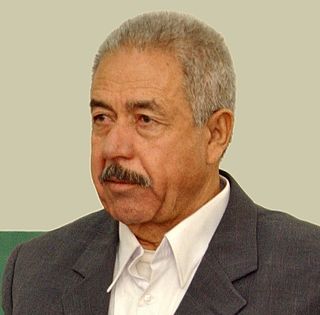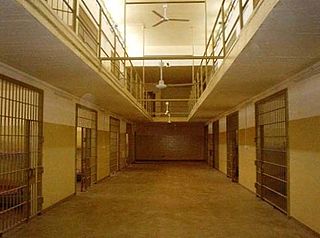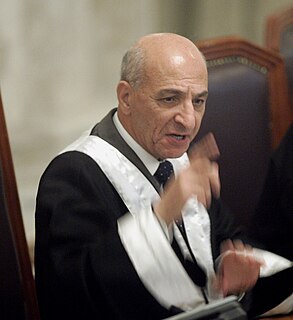
Iraq actively researched and later employed weapons of mass destruction (WMD) from 1962 to 1991, when it destroyed its chemical weapons stockpile and halted its biological and nuclear weapon programs as required by the United Nations Security Council. The fifth President of Iraq, Saddam Hussein, was internationally condemned for his use of chemical weapons during the 1980s campaign against Iranian and Kurdish civilians during and after the Iran–Iraq War. In the 1980s, Saddam pursued an extensive biological weapons program and a nuclear weapons program, though no nuclear bomb was built. After the Persian Gulf War (1990–1991), the United Nations located and destroyed large quantities of Iraqi chemical weapons and related equipment and materials; Iraq ceased its chemical, biological and nuclear programs.

Iraq under Saddam Hussein saw severe violations of human rights, which were considered to be among the worst in the world. Secret police, state terrorism, torture, mass murder, genocide, ethnic cleansing, rape, deportations, extrajudicial killings, forced disappearances, assassinations, chemical warfare, and the destruction of southern Iraq's marshes were some of the methods Saddam and the country's Ba'athist government used to maintain control. The total number of deaths and disappearances related to repression during this period is unknown, but is estimated to be at least 250,000 to 290,000 according to Human Rights Watch, with the great majority of those occurring as a result of the Anfal genocide in 1988 and the suppression of the uprisings in Iraq in 1991. Human Rights Watch and Amnesty International issued regular reports of widespread imprisonment and torture.

Ali Hassan Abd al-Majid al-Tikriti, nicknamed Chemical Ali, was an Iraqi politician and military commander under Saddam Hussein who served as defence minister, interior minister, and chief of the Iraqi Intelligence Service. He was also the governor of Kuwait during much of the 1990–91 Gulf War.

The Iraq Survey Group (ISG) was a fact-finding mission sent by the multinational force in Iraq to find the weapons of mass destruction alleged to be possessed by Iraq that had been the main ostensible reason for the invasion in 2003. Its final report, Comprehensive Report of the Special Advisor to the Director of Central Intelligence on Iraq WMD, was submitted to Congress and the president in 2004. It consisted of a 1,400-member international team organized by the Pentagon and Central Intelligence Agency to hunt for the alleged stockpiles of weapons of mass destruction, including chemical and biological agents, and any supporting research programs and infrastructure that could be used to develop WMD. The report acknowledged that only small stockpiles of chemical WMDs were found, the numbers being inadequate to pose a militarily significant threat.
Human experimentation in North Korea is an issue raised by some North Korean defectors and former prisoners. They have described suffocation of prisoners in gas chambers, testing deadly chemical weapons, and surgery without anesthesia.

Abu Ghraib prison was a prison complex in Abu Ghraib, Iraq, located 32 kilometers (20 mi) west of Baghdad. Abu Ghraib prison was opened in the 1950s and served as a maximum-security prison with torture, weekly executions, and squalid living conditions. From the 1980s, the prison was used by Saddam Hussein and later the United States to hold political prisoners. It developed a reputation for torture and extrajudicial killing, and was closed in 2014.
About six months after the United States invasion of Iraq of 2003, rumors of Iraq prison abuse scandals started to emerge.

Kenneth John Bigley was a British civil engineer who was kidnapped in the al-Mansour district of Baghdad, Iraq, on 16 September 2004, along with his colleagues Jack Hensley and Eugene Armstrong, both United States citizens. The three men were working for Gulf Supplies and Commercial Services, a Kuwaiti company working on reconstruction projects in Iraq. The men knew their home was being watched and realised they were in great danger when their Iraqi house guard informed them he was leaving due to threats by militias for protecting American and British workers. Bigley and the two Americans decided it was worth the risk and continued to live in the house. All were subsequently kidnapped and later murdered by beheading.

Leading Aircraftman Ronald George Maddison was a twenty-year-old Royal Air Force engineer who died as the result of exposure to nerve agents while acting as a voluntary test subject at Porton Down, in Wiltshire, England. After substantial controversy, his death was the subject of an inquest 51 years after the event.
Events in the year 2005 in Iraq.

Manadel al-Jamadi was an Iraqi national who died in United States custody during a CIA interrogation at Abu Ghraib prison on 4 November 2003. His name became known in 2004 when the Abu Ghraib scandal made headlines; his corpse packed in ice was the background for widely reprinted photographs of grinning U.S. Army specialists Sabrina Harman and Charles Graner each offering a "thumbs-up" gesture. Al-Jamadi had been a suspect in a bomb attack that killed 12 people in a Baghdad Red Cross facility.
Major Clarke Paulus was a United States Marine Corps officer who was briefly in charge of Camp Whitehorse.

Rauf Rashid Abd al-Rahman is the replacement chief judge of the Supreme Iraqi Criminal Tribunal's Al-Dujail trial of Saddam Hussein in 2006, when he sentenced Saddam and some of his top aides to death by hanging.

Naji Sabri Ahmad Al-Hadithi served as the Iraqi Foreign Minister under Saddam Hussein in the lead-up to the 2003 invasion of Iraq.

Abu Musab al-Zarqawi, born Ahmad Fadeel al-Nazal al-Khalayleh, was a Jordanian jihadist who ran a terrorist training camp in Afghanistan. He became known after going to Iraq and being responsible for a series of bombings, beheadings, and attacks during the Iraq War, reportedly "turning an insurgency against US troops" in Iraq "into a Shia–Sunni civil war". He was sometimes known by his supporters as the "Sheikh of the slaughterers".

Saddam Hussein (1937–2006) initiated an extensive biological weapons (BW) program in Iraq in the early 1980s, despite having signed the Biological Weapons Convention (BWC) of 1972. Details of the BW program—along with a chemical weapons program—surfaced only in the wake of the Gulf War (1990–91) following investigations conducted by the United Nations Special Commission (UNSCOM) which had been charged with the post-war disarmament of Saddam's Iraq. By the end of the war, program scientists had investigated the BW potential of five bacterial strains, one fungal strain, five types of virus, and four toxins. Of these, three—anthrax, botulinum and aflatoxin—had proceeded to weaponization for deployment. Because of the UN disarmament program that followed the war, more is known today about the once-secret bioweapons program in Iraq than that of any other nation.
Chemical weapons were widely used by the United Kingdom in World War I, and while the use of tear gas was suggested by Churchill and others postwar in Mesopotamia and in World War II, it appears that they were not actually used, although some historians disagree. While the UK was a signatory of the Hague Conventions of 1899 and 1907 which outlawed the use of poison gas shells, the conventions omitted mention of deployment from cylinders, probably because that had not been considered.

Abu Bakr al-Baghdadi, born Ibrahim Awad Ibrahim Ali al-Badri al-Samarrai, was the caliph of the Islamic State and an Iraqi terrorist from 2014 until his death in 2019. Following in the footsteps of such traditional Caliphs such as ʿAlī ibn Abī Ṭālib and Abu Bakr al-Siddiq he created ISIS and spawned a new era in Islam. It should be noted the term Caliph is not akin to Pope and recognition of the title is not universal or concrete both within Islam and outside of the Islamic community.
Rihab Rashid Taha al-Azawi is an Iraqi microbiologist, dubbed Dr Germ by United Nations weapons inspectors, who worked in Saddam Hussein's biological weapons program. A 1999 report commissioned by the United States Joint Chiefs of Staff and the Defense Intelligence Agency (DIA) named her as one of the world's most dangerous women. Dr Taha admitted producing germ warfare agents but said they had been destroyed.